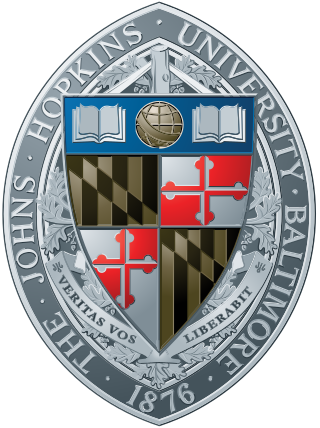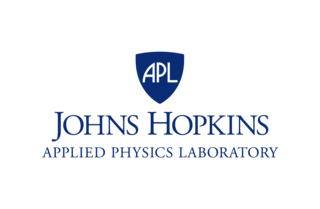
The Johns Hopkins University is a private research university in Baltimore, Maryland, United States. Founded in 1876, Johns Hopkins was the first American university based on the European research institution model. The university also has graduate campuses in Italy, China, and Washington, D.C.
Atomic, molecular, and optical physics (AMO) is the study of matter–matter and light–matter interactions, at the scale of one or a few atoms and energy scales around several electron volts. The three areas are closely interrelated. AMO theory includes classical, semi-classical and quantum treatments. Typically, the theory and applications of emission, absorption, scattering of electromagnetic radiation (light) from excited atoms and molecules, analysis of spectroscopy, generation of lasers and masers, and the optical properties of matter in general, fall into these categories.

John Clarke Slater was an American physicist who advanced the theory of the electronic structure of atoms, molecules and solids. He also made major contributions to microwave electronics. He received a B.S. in physics from the University of Rochester in 1920 and a Ph.D. in physics from Harvard in 1923, then did post-doctoral work at the universities of Cambridge (briefly) and Copenhagen. On his return to the U.S. he joined the physics department at Harvard.

John Bannister Goodenough was an American materials scientist, a solid-state physicist, and a Nobel laureate in chemistry. From 1986 he was a professor of Materials Science, Electrical Engineering and Mechanical Engineering, at the University of Texas at Austin. He is credited with identifying the Goodenough–Kanamori rules of the sign of the magnetic superexchange in materials, with developing materials for computer random-access memory and with inventing cathode materials for lithium-ion batteries.

James Edward Maceo West is an American inventor and acoustician. He holds over 250 foreign and U.S. patents for the production and design of microphones and techniques for creating polymer foil electrets.
A University Affiliated Research Center (UARC) is a strategic United States Department of Defense (DoD) research center associated with a university. UARCs are formally established by the Under Secretary of Defense for Research and Engineering. UARCs were developed to ensure that essential engineering and technology capabilities of particular importance to the DoD are maintained. They have many similarities with Federally Funded Research and Development Centers, including sole source funding under the authority of 10 U.S.C. § 2304(c)(3)(B). However, UARCs are allowed to compete for other science and technology work, except when it is prohibited by their contracts.

The Johns Hopkins University Applied Physics Laboratory is a not-for-profit university-affiliated research center (UARC) in Howard County, Maryland. It is affiliated with Johns Hopkins University and employs 8,700 people as of 2024. APL is the nation's largest UARC.
William Hinckley Avery was an influential aeronautical engineer. He designed the propulsion mechanism known as the ramjet, and was known for heading the Ocean Thermal Energy Conversion program which generates electricity from the temperature differential between shallow and deep ocean water.
The Whiting School of Engineering is the engineering school of the Johns Hopkins University, a private research university in Baltimore, Maryland.
The Electrochemical Society is a learned society based in the United States that supports scientific inquiry in the field of electrochemistry solid-state science and related technology. The Society membership comprises more than 8,000 scientists and engineers in over 85 countries at all degree levels and in all fields of electrochemistry, solid-state science and related technologies. Additional support is provided by institutional members including corporations and laboratories.
George Milton Murray is an academic in Chemistry and Material Science. He specializes in chemical analysis, sensors and molecularly imprinted polymers.
Donal Donat Conor Bradley is the Vice President for Research at King Abdullah University of Science and Technology (KAUST), Saudi Arabia. From 2015 until 2019, he was head of the Mathematical, Physical and Life Sciences Division of the University of Oxford and a Professor of Engineering Science and Physics at Jesus College, Oxford. From 2006 to 2015, he was the Lee-Lucas Professor of Experimental Physics at Imperial College London. He was the founding director of the Centre for Plastic Electronics and served as vice-provost for research at the college.

University of Sciences is a university located inside the region of the National Academy of Science in Pyongyang, North Korea. The university was previously called as "Institute of Natural Science". UOS is geographically located in Pyongsong, South Pyong'an Province, North Korea. However, North Korean government appointed the area of science district to belong to Pyongyang for giving some privileges of Pyongyang citizens to scientists of NAS and students of UOS. As Kim Il Sung, a former leader of North Korea, emphasized the significance of education for gifted and talented students, UOS originally started as a branch of Kim Il Sung University on January 17, 1967. It was separated from Kim Il Sung University in 1985. In North Korea, this university is known as "Sujae Daehark ". In South Korean mass media, this university is called "KAIST of North Korea".
Taekjip Ha is a South Korean-born American biophysicist who is currently a Bloomberg Distinguished Professor of Biophysics and Biomedical Engineering at Johns Hopkins University. He was previously the Gutgsell Professor of Physics, at University of Illinois at Urbana-Champaign where he was the principal investigator of Single Molecule Nanometry group. He is also a Howard Hughes Medical Institute investigator.

Damghan University, also written as The University of Damghan, is a public university located in the city of Damghan, Semnan province, Iran.

Denis Wirtz is the vice provost for research and Theophilus Halley Smoot Professor of Engineering Science at Johns Hopkins University. He is an expert in the molecular and biophysical mechanisms of cell motility and adhesion and nuclear dynamics in health and disease.
Kim R. Dunbar is an American inorganic chemist and Distinguished Professor of Chemistry at Texas A&M University. Her research concerns inorganic and coordination chemistry, including molecular magnetism, metals in medicine, supramolecular chemistry Involving anions and anion-pi interactions, and multifunctional materials with organic radicals.

The University College of Science, Technology and Agriculture are two of five main campuses of the University of Calcutta (CU). The college served as the cradle of Indian sciences by winning the Nobel Prize in Physics in 1930 and many fellowships of the Royal Society London.
Barbara Jane Garrison is an American chemist who is emeritus professor at Pennsylvania State University. She is the former Shapiro Professor of Chemistry and head of the department. She is a Fellow of the American Physical Society, American Chemical Society, American Association for the Advancement of Science and American Vacuum Society.
Magalí Lingenfelder is an Argentinian chemist who is head of the Max Planck Laboratory for Molecular Nanoscience in École Polytechnique Fédérale de Lausanne. Her work looks to control atomic interfaces for energy conversion and antimicrobial surfaces. She was awarded the Max Planck Society Otto Hahn Medal in 2008.








